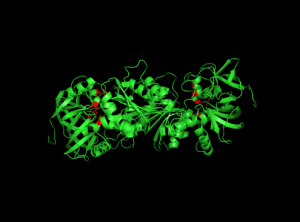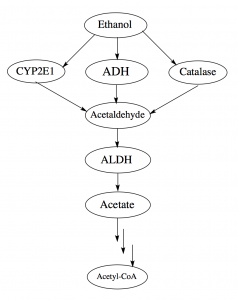When alcohol, in the form of ethanol, is consumed, the majority enters the systemic circulation where it can then be metabolized in the liver via the enzyme alcohol dehydrogenase (ADH). ADH, as well as cytochrome P450 (CYP2E1) and catalase to lesser extents, are responsible for the oxidation of ethanol, which removes around 90% of the ethanol absorbed in the body. ADH oxidizes ethanol to acetaldehyde, while reducing NAD+ to NADH, which is then oxidized to acetate by the enzyme aldehyde dehydrogenase (ALDH), reducing another equivalent of NAD+ to NADH. The acetate produced via ALDH in the liver is then transported to peripheral tissues where it is converted to Acetyl-CoA. Therefore, the carbon atoms entering the body in ethanol are ultimately incorporated into the same product as the breakdown pathways of proteins, carbohydrates, and fats (3).

Figure 3: Alcohol dehydrogenase (ADH-1) is depicted above (4). Located in the cytosol of the liver, ADH is a dimeric enzyme with a zinc center in both 40 kDa subunits, shown in red. There are 6 classes of ADH, but class 1 ADH forms (containing the genes ADH1, ADH2, and ADH3) are those that catalyze the oxidation of alcohol.

I like how concise the ethanol metabolism explanation is. Great summary!
– For Figure 3, it might be helpful to include in the caption what the green and red ADH domains represent. I’m assuming the red is the Zinc centers but it’s not explicitly stated.
– Figure 4 is a little overwhelming. Could it be simplified at all? My suggestion would be highlighting the most important enzymes and intermediates in order to make the diagram easier to follow.
I agree that I like how concise your “answer” page is!
Figure 2 is good, and I like the simplified summary of ethanol metabolism. However, the way it is now, there is no distinction between enzymes and intermediates in the pathway. For example, ALDH is an enzyme that produces an intermediate, acetate, but I would have thought they were both intermediates. Perhaps you could show each intermediate structure (especially that of ethanol, which I think is important) and put the enzyme names beside each arrow. This would easier distinguish between the two. Showing the reductions of NAD+ to NADH may also be beneficial in this diagram.
I agree with Ioana that Figure 4 is a bit overwhelming. Especially without much of a caption, I don’t think it adds very much to this overview page. I think it should either be simplified to show the most important aspects (and explained), or not included on this particular page.
Nice and concise indeed!
Perhaps touching on how cytochrome P450 and catalase differ from alcohol dehydrogenase would help clarify Figure 2 – maybe include why these alternate pathways exist (location?) and how their intermediates differ (if that information is even out there.)
I also noticed that in your “Question” page, you asked why certain drugs can’t be taken with alcohol, while this page did not answer that. I do like that second part of your question – it’d be very interesting to learn – but if you think you have enough information already, then maybe you should get rid of that second question.
I also agree with my partners in that highlighting some important compounds/intermediates in Figure 4 would help guide the reader’s eyes. Maybe highlighting a certain pathway of interest would help visually, though the only compounds you seem to focus on are ethanol, ADH and acetaldehyde, and this is more of a precursor pathway to a bunch of other pathways. Even so, a little highlighting of this precursor pathway might make it easier to see where the acetaldehyde and reducing power of ADH go.
Hello tufts.edu owner, Good to see your posts!
I was just searching for this info for a while. After 6 hours of continuous Googleing, at last I got it in your website. I wonder what is the lack of Google strategy that don’t rank this kind of informative websites in top of the list. Usually the top web sites are full of garbage.
We are a gaggle of volunteers and opening a new scheme in our community. Your website provided us with useful info to paintings on. You’ve done an impressive activity and our whole group shall be grateful to you.
Thanks for your article on the travel industry. I would also like to include that if your senior taking into consideration traveling, it truly is absolutely important to buy travel cover for golden-agers. When traveling, elderly people are at high risk of having a healthcare emergency. Obtaining right insurance cover package in your age group can safeguard your health and give you peace of mind.
Thanks , I’ve recently been searching for information approximately this topic for a while and yours is the greatest I’ve came upon so far. But, what in regards to the bottom line? Are you positive concerning the supply?
Many thanks for this article. I would also like to say that it can often be hard if you find yourself in school and simply starting out to initiate a long credit history. There are many college students who are only trying to endure and have an extended or beneficial credit history can occasionally be a difficult factor to have.
Hey There. I found your blog using msn. This is a really well written article. I will make sure to bookmark it and come back to read more of your useful information. Thanks for the post. I?ll certainly return.
Hiya, I am really glad I have found this info. Nowadays bloggers publish just about gossips and internet and this is really annoying. A good site with interesting content, that’s what I need. Thank you for keeping this website, I will be visiting it. Do you do newsletters? Cant find it.
Ten artykuł jest interesujący, ale na naszej stronie znajdziecie więcej informacji.
danube delta romania
One other thing is that an online business administration diploma is designed for learners to be able to well proceed to bachelor’s degree courses. The 90 credit diploma meets the other bachelor diploma requirements and when you earn your own associate of arts in BA online, you will have access to the most up-to-date technologies in such a field. Several reasons why students would like to get their associate degree in business is because they are interested in this area and want to find the general instruction necessary just before jumping into a bachelor college diploma program. Thanks for the tips you really provide inside your blog.
Your place is valueble for me. Thanks!?
Howdy! This is my first visit to your blog! We are a group of volunteers and starting a new initiative in a community in the same niche. Your blog provided us beneficial information to work on. You have done a extraordinary job!
Hello There. I found your blog using msn. This is a very well written article. I?ll be sure to bookmark it and come back to read more of your useful information. Thanks for the post. I?ll certainly comeback.
I find myself enraptured by the mellifluous symphony of your words, harmoniously entwined with your erudite observations and discerning commentary, embellishing each blog post with a tapestry of intellectual brilliance.